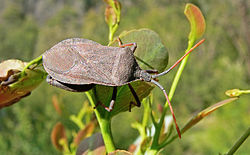| Coreinae Temporal range: | |
|---|---|
 | |
| Male Amorbus rubiginosus (Amorbini) | |
| Scientific classification | |
| Kingdom: | Animalia |
| Phylum: | Arthropoda |
| Class: | Insecta |
| Order: | Hemiptera |
| Suborder: | Heteroptera |
| Family: | Coreidae |
| Subfamily: | Coreinae Leach, 1815 [1] |
| Tribes | |
See text | |
Coreinae [2] is a subfamily in the hemipteran family Coreidae. They have been shown to be paraphyletic with respect to Meropachyinae. [3]

